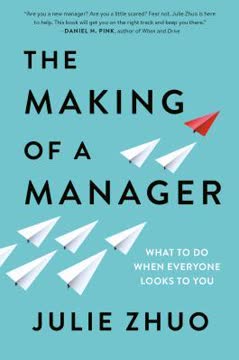Key Takeaways
1. Trust and vulnerability are foundational to effective engineering management
"Trust is built in drops and lost in buckets"
Build trust gradually. Trust is the cornerstone of any successful team, but it takes time to develop. As a manager, you must lead by example, showing vulnerability and admitting mistakes. This creates an environment where team members feel safe to take risks and be honest.
Foster psychological safety. Encourage open communication and create spaces where team members can express concerns without fear of judgment. This might include:
- Regular one-on-ones
- Team retrospectives
- Anonymous feedback channels
Demonstrate care. Show genuine interest in your team members' well-being and career goals. This builds stronger relationships and increases loyalty.
2. Prioritize your team's happiness and drive for optimal performance
"The fact that you're worried that you're not a good manager is a key part of being a good manager."
Create a positive work environment. Happy teams are more productive and innovative. Focus on:
- Celebrating wins, big and small
- Providing meaningful work
- Offering opportunities for growth and learning
Foster intrinsic motivation. Help team members connect their work to larger goals and personal values. This creates a sense of purpose and ownership.
Encourage flow states. Set up conditions that allow for deep, focused work:
- Minimize interruptions
- Provide challenging but achievable tasks
- Ensure clear goals and feedback
3. Provide clear career paths and regular feedback to foster growth
"If you don't know where you are going, you might wind up someplace else."
Implement career laddering. Create a clear framework for progression within your organization. This should outline:
- Skills and competencies needed at each level
- Expectations for different roles
- Potential career paths
Conduct regular career discussions. Use tools like:
- 30/60/90 day plans
- Quarterly goal-setting sessions
- Annual performance reviews
Align individual goals with company objectives. Help team members see how their work contributes to the bigger picture, increasing engagement and motivation.
4. Master the art of giving and receiving feedback for continuous improvement
"Caring personally doesn't mean personalizing."
Practice radical candor. Give feedback that is both kind and clear. Focus on specific behaviors and their impact, not personal attributes.
Create a feedback-rich culture. Encourage regular, bi-directional feedback:
- Manager to employee
- Employee to manager
- Peer to peer
Receive feedback gracefully. Model openness to feedback by:
- Actively seeking it out
- Listening without defensiveness
- Taking action on constructive criticism
5. Run efficient meetings that respect everyone's time and input
"Part of the purpose of the meeting is the discussion itself."
Have a clear purpose and agenda. Every meeting should have:
- A defined goal
- A written agenda shared in advance
- Clear roles (facilitator, note-taker, etc.)
Encourage participation. Create an inclusive environment where all voices are heard:
- Use round-robin techniques
- Employ silent brainstorming
- Call on quieter team members
End with action items. Conclude each meeting by:
- Summarizing decisions made
- Assigning clear next steps and owners
- Setting deadlines for follow-up
6. Manage conflicts productively to drive innovation and collaboration
"Conflict is actually a very necessary and healthy part of a productive working environment."
Embrace productive conflict. Encourage healthy debate and differing viewpoints to drive innovation and better decision-making.
Address issues promptly. Don't let conflicts fester. Have difficult conversations early and often to prevent escalation.
Focus on shared goals. When conflicts arise, remind team members of the common purpose and objectives they're working towards.
Use conflict resolution techniques:
- Active listening
- Seeking to understand all perspectives
- Finding win-win solutions when possible
7. Balance product and engineering work to maximize team impact
"It's not enough for us to go fast. You can run fast in the wrong direction."
Allocate time strategically. Set clear expectations for how time should be split between:
- New feature development
- Technical debt reduction
- Infrastructure improvements
Communicate priorities clearly. Ensure the entire team understands:
- Current focus areas
- Reasoning behind decisions
- Expected outcomes
Be flexible. Adjust the balance as needed based on:
- Business goals
- Technical challenges
- Team feedback
8. Scope down projects and PRs for faster iteration and better outcomes
"Small PRs keep the conversation focused, and as such reduce the need for any communication gymnastics."
Break work into smaller chunks. Encourage team members to:
- Create focused, single-purpose pull requests
- Use feature flags for gradual rollouts
- Submit work-in-progress PRs for early feedback
Improve review processes. Make code reviews more efficient by:
- Setting clear expectations for reviewers
- Using automated tools for style and basic checks
- Encouraging pair programming for complex changes
Iterate quickly. Embrace rapid feedback cycles to:
- Catch issues early
- Reduce wasted effort
- Maintain team momentum
9. Prioritize tasks based on values and energy levels for peak productivity
"Your actions show you what you actually want."
Align work with personal values. Regularly reflect on your core values and ensure your work aligns with them. This increases motivation and satisfaction.
Work with your natural rhythms. Identify your peak energy times and schedule important tasks accordingly:
- High-energy times: Deep work, creative tasks
- Low-energy times: Administrative work, routine tasks
Use prioritization techniques:
- Eisenhower Matrix (Urgent vs. Important)
- Time-boxing
- Personal kanban boards
10. Set healthy boundaries to maintain work-life balance and avoid burnout
"Saying no when someone initially asks, not down the line, is important."
Learn to say no. Protect your time and energy by declining commitments that don't align with your priorities or values.
Establish clear work hours. Communicate your availability to your team and stick to it as much as possible.
Practice self-care. Prioritize activities that recharge you:
- Regular exercise
- Hobbies and interests outside of work
- Time with family and friends
Delegate effectively. Trust your team members with responsibilities and avoid micromanagement.
Last updated:
FAQ
What's "Engineering Management for the Rest of Us" about?
- Overview: "Engineering Management for the Rest of Us" by Sarah Drasner is a comprehensive guide for both aspiring and current engineering managers. It provides practical advice on managing teams, fostering collaboration, and enhancing productivity.
- Target Audience: The book is designed for those who have transitioned from engineering roles to management, often without formal training, and need guidance on leading effectively.
- Content Structure: It is divided into four parts: Your Team, Collaboration, Helping Your Team Do Their Best Work, and Your Work, each focusing on different aspects of engineering management.
- Real-World Examples: The book includes real-world examples and anecdotes to illustrate key points, making it relatable and actionable for readers.
Why should I read "Engineering Management for the Rest of Us"?
- Practical Advice: The book offers actionable tips and strategies for managing engineering teams, making it a valuable resource for new and experienced managers alike.
- Empathy and Passion: Sarah Drasner emphasizes empathy and passion in leadership, encouraging managers to build trust and psychological safety within their teams.
- Comprehensive Coverage: It covers a wide range of topics, from career laddering and feedback to conflict management and prioritization, providing a holistic view of engineering management.
- Relatable and Engaging: The book is written in an engaging and often humorous style, making complex management concepts accessible and enjoyable to read.
What are the key takeaways of "Engineering Management for the Rest of Us"?
- Trust and Vulnerability: Building trust and modeling vulnerability are crucial for effective team management and fostering a supportive work environment.
- Prioritization and Clarity: Managers should focus on aligning teams with clear objectives and priorities to ensure efficient execution and avoid chaos.
- Feedback and Growth: Constructive feedback is essential for personal and team growth, and managers should create a culture where feedback is welcomed and acted upon.
- Self-Care and Resilience: Managers need to prioritize their own well-being to maintain resilience and effectively support their teams.
How does Sarah Drasner define "values" in the context of engineering management?
- Core Beliefs: Values are fundamental beliefs that guide actions and decisions, helping individuals and teams determine what is important.
- Individual and Team Values: Understanding both individual and team values can provide context for behavior and help build mutual understanding and trust.
- Values Exercises: Drasner suggests conducting values exercises with teams to uncover shared values and foster a supportive and cohesive work environment.
- Alignment and Boundaries: Aligning work with personal and team values can prevent burnout and ensure that boundaries are respected.
What is the importance of "trust and vulnerability" according to Sarah Drasner?
- Foundation of Teamwork: Trust is the foundation of effective teamwork, enabling open communication, collaboration, and innovation.
- Modeling Vulnerability: Managers should model vulnerability by admitting mistakes and showing empathy, which encourages team members to do the same.
- Building Trust: Trust is built gradually through consistent actions and communication, and it can be easily lost if not nurtured.
- Impact on Performance: High-trust teams tend to perform better, as trust fosters a positive work environment and reduces fear of failure.
How does "Engineering Management for the Rest of Us" address feedback?
- Feedback as a Partnership: Feedback should be viewed as a partnership aimed at mutual growth, rather than a top-down directive.
- Constructive and Timely: Feedback should be specific, constructive, and delivered as soon as possible to be effective and actionable.
- Receiving Feedback: Managers should also seek feedback to improve their leadership skills and demonstrate a culture of continuous learning.
- Feedback Challenges: The book acknowledges the challenges of giving and receiving feedback, emphasizing the need for empathy and understanding.
What strategies does Sarah Drasner suggest for "prioritizing your team's work"?
- Align with Objectives: Prioritize tasks that align with the team's objectives and key results (OKRs) to ensure focus and clarity.
- Break Down Tasks: Break down large projects into manageable tasks to facilitate progress tracking and reduce overwhelm.
- Use of Tools: Utilize tools like kanban boards and labels to organize and visualize work, making it easier to manage and prioritize.
- Regular Review: Regularly review and adjust priorities based on changing circumstances and feedback to maintain alignment with goals.
How does the book suggest handling "conflicts" within a team?
- Embrace Conflict: View conflict as an opportunity for growth and innovation, rather than something to be avoided.
- Separate Ideas from Identity: Encourage team members to focus on ideas rather than personal identities to facilitate productive discussions.
- Immediate Action: Address conflicts promptly to prevent them from escalating and affecting team morale and productivity.
- Values and Conflict: Understanding team members' values can provide insight into conflicts and help find common ground for resolution.
What is the role of "career laddering" in engineering management according to the book?
- Defining Expectations: Career laddering provides a clear framework for what is expected at different levels of a role, guiding career progression.
- Clarity and Growth: It offers clarity on growth paths, helping employees understand how to advance and what skills to develop.
- Partnership Approach: Managers should work with employees to align career laddering with personal goals and company needs, fostering a sense of partnership.
- Regular Review: Regularly reviewing career ladders ensures they remain relevant and aligned with both individual and organizational goals.
How does Sarah Drasner recommend "setting boundaries" as a manager?
- Importance of Boundaries: Setting boundaries is crucial for maintaining personal well-being and preventing burnout in a demanding role.
- Saying No: Learn to say no to tasks that do not align with priorities or values, and communicate boundaries clearly to others.
- Balance and Flexibility: Balance is key, and boundaries should be flexible enough to adapt to changing circumstances without compromising core values.
- Modeling Behavior: Managers should model healthy boundary-setting behavior to encourage their teams to do the same.
What are some of the best quotes from "Engineering Management for the Rest of Us" and what do they mean?
- "Trust is built in drops and lost in buckets." This quote emphasizes the gradual nature of building trust and how easily it can be lost, highlighting the importance of consistent, trustworthy actions.
- "The fact that you’re worried that you’re not a good manager is a key part of being a good manager." This reflects the idea that self-awareness and concern for one's effectiveness are crucial traits of a good manager.
- "If everything is important, nothing is." This underscores the necessity of prioritization, as trying to do everything at once leads to inefficiency and lack of focus.
- "You can’t call yourself a leader by coming into a situation that is by nature uncertain, ambiguous—and create confusion. You have to create clarity where none exists." This quote highlights the leader's role in providing clarity and direction amidst uncertainty.
How does "Engineering Management for the Rest of Us" address "self-care and resilience" for managers?
- Self-Care Importance: Self-care is essential for maintaining resilience and effectiveness as a manager, preventing burnout and stress.
- Finding Joy: Managers should find joy in small moments and practice gratitude to enhance resilience and maintain a positive outlook.
- Gratitude Journaling: Keeping a gratitude journal can help shift focus from negativity to positivity, improving mental well-being.
- Support Systems: Building a support system, including coaching and mentorship, provides managers with the resources and encouragement needed to navigate challenges.
Review Summary
Engineering Management for the Rest of Us receives mostly positive reviews, praised for its practical advice, approachable style, and focus on trust and human dynamics. Readers appreciate the author's personal experiences and insights. Some find it an excellent resource for new managers, while others note it covers basics without delving deep. Critics mention it may be too simplistic for experienced managers. Overall, it's considered a valuable guide for those transitioning to engineering management, offering a balance of theory and practical advice.
Similar Books










Download PDF
Download EPUB
.epub digital book format is ideal for reading ebooks on phones, tablets, and e-readers.




